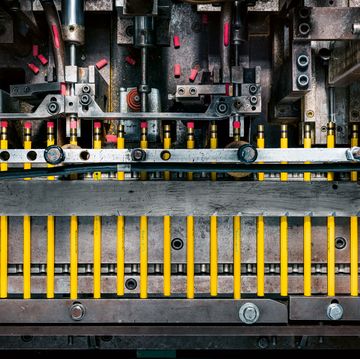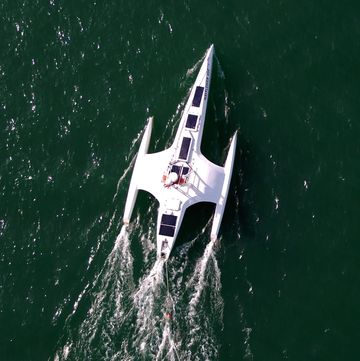Before the folks at John Deere's Coal Valley Demonstration Grounds allowed me to get behind the wheel of their enormous yellow $246,000 544K 4WD Loader, they insisted that I complete some training. This was not a bad idea—I was likely the least experienced operator who had ever visited the facility. I've never even driven a riding mower. Fortunately, Deere had a solution, and one that also works for educating veteran construction-equipment drivers: computer simulators.
John Deere's sophisticated video games are built around desktop computers, large flat-screen TVs, and the disembodied controls of their five most iconic earthmovers. Here, inside an air-conditioned, linoleum-tiled viewing bunker that resembled the VIP box at a Double A baseball stadium, I would learn to drive a backhoe, loader, and more. I felt as if I were trespassing into the green-screen room on the set of Bob the Builder, or a 9-year-old boy's vision of the ultimate man cave.
After a cursory briefing, Jandi Ludin, Deere's senior instructional designer and my personal trainer for the day, had me slide into the open cab of the mock excavator and attempt one of the tutorials.
My initial results were not encouraging. Though I gripped the thick, omni-directional joysticks with all of the assurance I could muster, while trying to use it to maneuver a dangling metal culvert pipe with the steam shovel's toothed bucket, I touched the vehicle's extended metal arm to some overhead power lines. Then I crushed one of my pixilated coworkers.
Slightly distraught, I moved on to the motor grader. Though you might not know this immediately based on the eight knobs—four for each hand, used to manipulate its various parts—this machine is intended to smooth uneven surfaces via a wide movable blade beneath its protracted snout. But instead of leveling piles of freshly dumped dirt, I cratered them irreparably. And in an effort to razor off a tree stump, I nearly rolled into an ersatz pond.
My next simulated attempt was at trenching with a backhoe, a twin-armed behemoth that features both a front-mounted scoop and a rear-mounted claw—operated by separate (and seemingly sentient) multivalent levers, and shoveling via completely disparate modalities. I was so confounded by the requisite inputs that at one point I simply released the controls and turned to Ludin. "Can you show me a picture of this machine and explain how it moves?" She looked at me like I was a talking dog.
But once I began working with the loader, things started to turn around. Despite repeatedly striking the broad metal bucket against the side of the dump truck toward which I was meant to be ferrying rock—and hyperextending my load directly over the truck cab housing one of my "colleagues"—I felt comparatively in command of the controls. I even managed to move nearly one full truckload of gravel, albeit in the time allotted for shoveling three. I credited the presence of a steering wheel—the first to appear in any of the simulators—and the feedback provided by Deere's optional submounted motion platform, which added realistic pitching and clunking. Also, the fact that I'd donned a hard hat.
After this marginal success, I was ready to apply my knowledge. This meant leaving the air-conditioning, walking across an area known as the Sand Box—a hot, dusty plain littered with debris and earthmovers—and clambering into the cab of an actual 544K 4WD Loader. Expert operator Marty Belshause followed me up the three-rung ladder and showed me the controls, which comfortingly mimicked those in the simulator. But when he asked if I was ready to dig, I panicked. "Alone?" Marty glanced around and said, "There's only one seat."
I took two tenuous test laps around the Sand Box before launching toward my objective: a five-story mesa of rubble, on top of which toiled a mammoth excavator. I worried that my chipping at the base might unmoor the entire pile. But these fears were unfounded—in part because on my first attempt, my bucket was turned rounded side out, so I managed only to stroke the mound's foundation.
Recalling the "Return To Dig" feature from my training, I jabbed the joystick and placed the bucket in the proper open-underbite position. I then pushed the shifter forward to lower the boom, eased my foot onto the gas pedal, and plowed ahead. Success! Lifting the bucket and curling it in jerkily, I shifted into reverse and backed up. Then I drove forward, completing a motion-saving V maneuver—just as I'd learned on screen!—and approached the pile's distant edge. I dispatched my load. No one died.
I completed a few more runs back and forth before deciding to retire while my safety rate was still perfect. "I'm sure that was the worst performance you've ever seen," I told Jandi. Apparently not. During a recent dealer demonstration, a giant dump truck turned too tightly and flipped over, spilling its entire payload. "What did everyone do?" I asked. Ludin shrugged. "Most people just assumed it was part of the show."
Brett Berk (he/him) is a former preschool teacher and early childhood center director who spent a decade as a youth and family researcher and now covers the topics of kids and the auto industry for publications including CNN, the New York Times, Popular Mechanics and more. He has published a parenting book, The Gay Uncle’s Guide to Parenting, and since 2008 has driven and reviewed thousands of cars for Car and Driver and Road & Track, where he is contributing editor. He has also written for Architectural Digest, Billboard, ELLE Decor, Esquire, GQ, Travel + Leisure and Vanity Fair.














